One of the most advanced and mysterious ancient society, the Indus River Valley civilization, was completely lost to history until the 1920s.
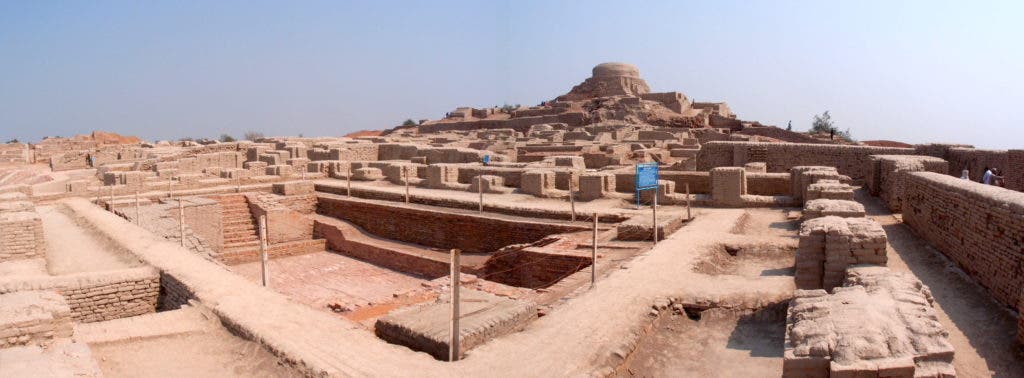
Some five millennia ago, a people settling the lands between today’s Afganistan, northwest India, and Pakistan rose to the forefront of civilization, knowledge, and sophistication at the time. The echoes of their achievements still awe us to this day, betraying a level of civilization almost unimaginable for a society that had, ultimately, risen directly from the Stone Age.
But this beacon of antiquity crumbled and was forgotten, likely under the weight of issues that fall worryingly close to those of today: food and water insecurity powered by climate change.
Who were the Harappans?
The Indus River Valley civilization, also known as the Harappan civilization after the first site of their discovery, is a Bronze Age culture that spanned roughly from 3300 to 1300 BC. It stood toe to toe with the three other ancient heavyweights of the world — Egypt, Mesopotamia, and ancient China — often surpassing their scientific achievements; out of the four ancient cradles of civilization, the people of the Indus Valley could claim to be the largest and arguably most prosperous.
Their success was built on a solid agricultural base (they grew various crops, from dates to cotton, in the fertile soils of the valley) and cutting-edge technologies, including indoor plumbing, sophisticated city-planning and public sewage systems, breakthroughs in crafting techniques, writing, and one of the most advanced understandings of metallurgy at the time. They also seem to have been a peaceful people; despite their skill with metal, we’ve found strikingly few Harappan weapons. Not the same thing can be said about their children’s toys, however, of which they seemingly couldn’t get enough of, both in quantity and variety.
The Harappans were one of the most mysterious groups to, tragically, never truly make it out of antiquity. Despite its status as an economic, technological, and social powerhouse, the Harappan civilization simply fell apart in a span of two or three centuries. The reasons as to why this happened are still a subject of passionate debate and they may be more relevant now than ever before.
Discovery

In 1856, British colonial officials in India were busy overseeing a railway construction project between the cities of Lahore and Karachi (today part of Pakistan), right along the valley of the Indus River. Digs performed as part of this effort stumbled upon an incredible stash of artifacts — hundreds of thousands of fire-baked bricks, buried in the dry terrain. They looked quite old, but some were nevertheless used for the railway’s track ballast or its roadbed. Soon, exquisitely-carved soapstone (steatite) artifacts were also making an appearance throughout the bricks. Unwittingly, these workers had unearthed the first slivers of a civilization lost in the depths of time.
Despite the sheer size of the discovery, major excavations didn’t start until much later. This is quite vexing, as the first recorded notes regarding the civilization come from 1826, penned by a British army deserter named James Lewis/Charles Masson, who noticed the presence of mounded ruins at the small local town of Harappa while posing as an American engineer. Partly, this exploratory lag came down to archaeologists assuming the bricks and ruins were crafted during the Maurya Empire, which dominated India between 322 and 185 BCE. It was only after excavation works started at the site in 1920 under John Marshall, then the director of the Archaeological Survey of India, that it became clear they were dealing with another culture altogether.
The newly re-discovered civilization would receive its name from this site at Harappa, and pushed the known history of India back by at least 1,500 years. In the meantime, archaeologists have scrambled to understand the Indus River Valley civilization — but we’ve been able to confirm frustratingly little from all we’ve found.
Size and origin
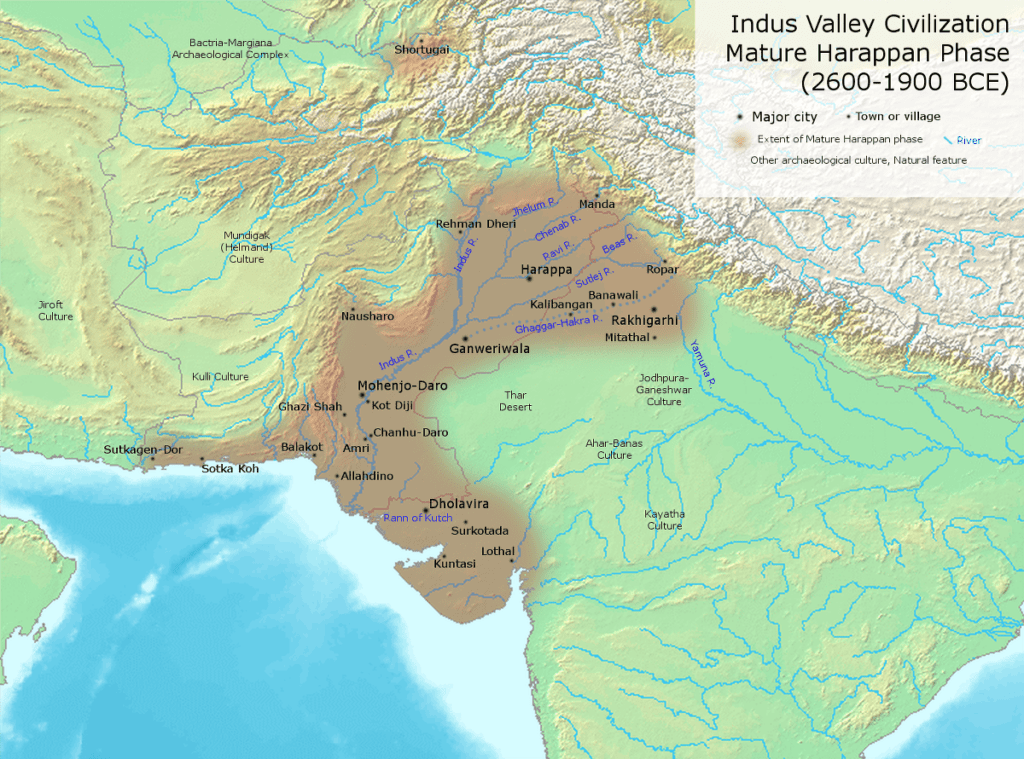
Image via Wikimedia Commons.
The Harappans seem to hail from a town named Mehgarh, nestled in the foothills of a mountain pass in today’s western Pakistan. Evidence points to human habitation in the area as far back as 7000 BC. Archaeologists have broken their evolution down into three steps or phases:
- Early Harappan from 3300 to 2600 BC,
- Mature Harappan from 2600 to 1900 BC, towards the end of which the civilization starts going into decline, and
- Late Harappan from 1900 to 1300 BC, marked by violence, breakdowns in social order, the abandonment of most settlements, and the eventual extinction of the Indus Valley people.
But while things were going well for the Harappans, they were really good. So far, more than 1,052 Harappan cities and settlements have been found, mainly in the general region of the Indus River and its tributary rivers. At their peak, they are estimated to have numbered five million souls.
Culture, language, and beliefs
One of the reasons why we can’t figure out what the Harappans were up to that well is because of their writing. We know they had a system of writing, because we found some of their texts, etched on clay and stone tablets dated between 3300-3200 BC, at Harappa. These appear to have been written right to left in a script which we, unfortunately, don’t understand. The symbols resemble plant and trident-like shapes and are completely unlike anything we’ve ever seen. This has led many researchers to believe that Harappan script evolved independently of those in Mesopotamia, Egypt, or China.
It also means that we don’t actually know any Harappan words, the name of their cities, or what they called themselves. We refer to them by names we ourselves have given them — just something to keep in mind as you read further on.
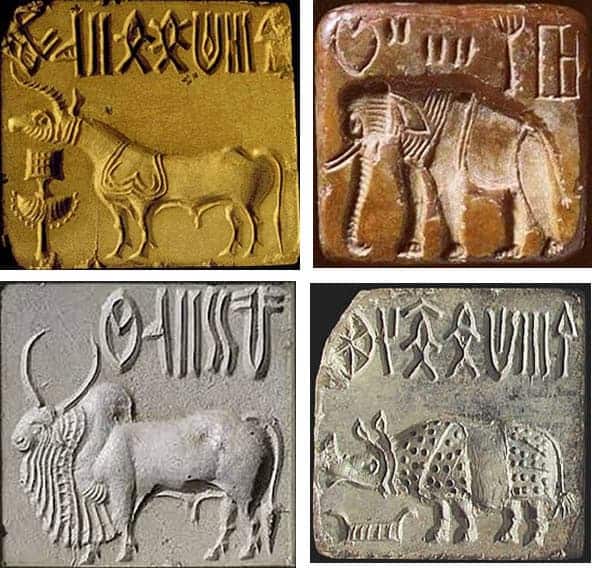
Image via omniglot.
In the absence of any known names or words, without any bi-lingual texts or clear cultural ties to compare or infer from, it’s nigh-impossible to understand the script of a dead language. But it does have the hallmarks of a language, researchers have found, a conclusion that is sure to goad curiosity further.
“At this point, we can say that the Indus script seems to have statistical regularities that are in line with natural languages,” said Rajesh Rao, a University of Washington researcher who led a study in 2009 analyzing if Indus script shows ‘conditional entropy’, a structural semi-predictability that underlies functional languages.
Indus Valley religion also eludes our understanding. Unlike their Egyptian and Mesopotamian counterparts, the Harappans didn’t build any temples or palaces (that we know of), so we don’t have any evidence pointing to specific deities or their religious practices. However, many of their artifacts (in the form of seals) showcase animals. Some depict them being carried in a ceremony, while others include downright mythological creatures such as unicorns. Thus, some researchers have speculated that religion in the Indus Valley centered, in some way, on animals. Others have suggested that the animals on these seals instead signified one’s membership to a group such as a clan, social class, so forth. Until more evidence is gleaned, neither can be fully supported or refuted.
We have, however, found ample evidence of Harappan art and culture, including sculptures, seals, pottery, gold jewelry, as well as anatomically detailed figurines in terracotta, bronze, and steatite.
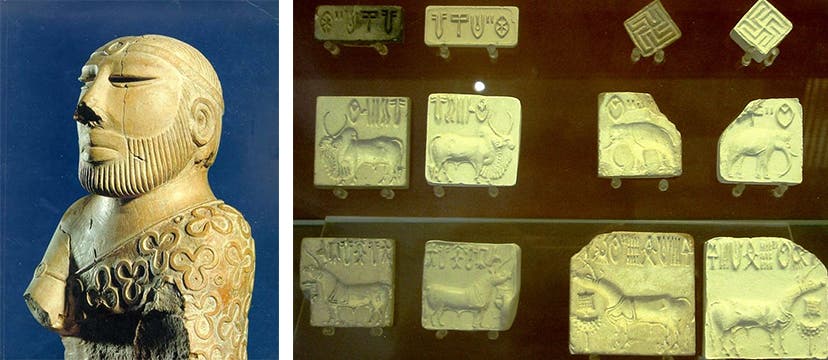
Images via Wikimedia, modified.
The evidence points to a flourishing culture, but their inscrutable texts, in particular, spell doom for our understanding of how these people ruled themselves — legal codes, procedures, and systems of governance, after all, are rooted in written documents. This, again, is highly frustrating, as we’re going to see that the Harappans were extremely adept at ordering and coordinating their society, for the benefits of all those it harbored.
Science and know-how
One of the most striking features of Harrapan society was their propensity for standardization. Pottery and seals use surprisingly similar proportions. Bricks are virtually identical in size, shape, weight, and material, even among different cities. Weighs used in trading are also virtually identical. The level of standardization is so high, in fact, that some researchers claim it could only be the product of a single state authority enforcing them on all communities in the area. However, the pointed scarcity of weapons makes it more likely that the Indus Valley people were led by a number of leaders representing each major community or cluster of communities, all working together voluntarily. This view is supported by studies on Indus graves and human remains that show everyone enjoyed similar health. The relative scarcity of elite burials suggests they had no rulers, as we understand the term, and that everyone enjoyed equal status.
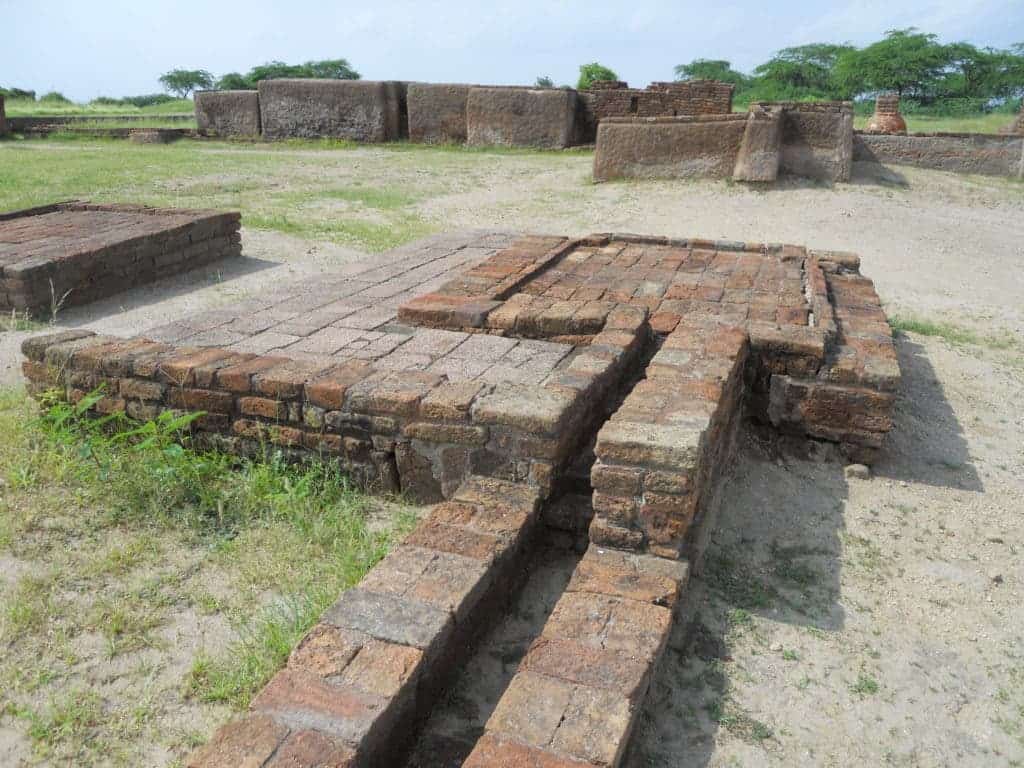
Image via Wikimedia.
While most of the Harappan settlements were only villages or small towns, the civilization had several large urban centers. Among those we’ve found are Harappa, Ganeriwala, and Mohenjo-daro in modern-day Pakistan and Dholavira, Kalibangan, Rakhigarhi, Rupar, and Lothal in modern-day India. Out of the lot, Mohenjo-daro became the largest city of the Indus Valley Civilization and holds the multiple distinction of being one of the world’s first major urban centers, as well as, at the time, one of the most sophisticated cities in the world and a global architectonical and engineering masterpiece.
The Harappan fire-baked brick was produced and used on a massive scale in construction. Not only were they surprisingly standardized, as we’ve seen, but they also took a lot more time, effort, specialized know-how, and resources to produce than sun-baked bricks, which were the norm at the time. One undeniable advantage that fire-baked bricks had (apart from being sturdier than sun-dried ones) was that they were perfectly water-proof — a quality we’ll see the Harappans putting to good use. It’s possible that this ability to carry water is what warranted, at least in part, the use of more costly and harder to produce fire-baked bricks in the Indus Valley.
The ruins of their major cities show that a lot of effort went into urban planning. Houses, workshops, and trading spots each formed distinct neighborhoods, and cities had well-organized wastewater drainage and trash collection systems, granaries, even public baths. This efficient layout further suggests that local governments were present and of high quality, working with great efficiency and aiming particularly to maintain public hygiene (or possibly, religious ritual).
Both Harappa and Mohenjo-daro featured citadels, heavily fortified areas thick with defensive structures — a feature other important and well-off cities likely shared. They had administrative (or, again, possibly religious) centers that were also fortified. The walls are speculated to have played a double role, protecting the Harappans both from invasions and floods.
Another distinctive feature of the Indus people was that they didn’t really build to awe. We know they were able to build impressive structures, as they show an advanced understanding of architecture with dockyards, granaries, cisterns, warehouses, and fortifications. But there’s no conclusive evidence that they ever built any palaces. Neither of temples. In fact, the largest Indus buildings we’ve found so far were likely granaries. The nearest thing we’ve found to a ‘monument’ is in Mohenjo-daro — the Great Bath, a public bathing and social area.
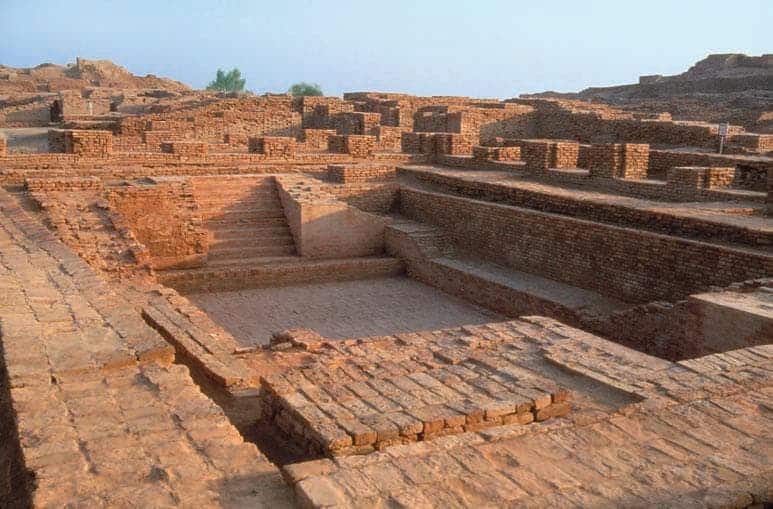
Image via Pinterest.
In addition to architecture and urban theory, Harappans made repeated breakthroughs in metalworking (which was the day’s rocket science), working copper, tin, lead, and bronze. They were skilled craftsman, as shown by their intricate works in stone, carnelian, bone, ivory, and a wide range of other common, precious, and semi-precious materials. Harappans are also considered the heralds of wheel-turned pottery in India.
They also made important advances in transport technology, being a contender for the “first civilization to use the wheel” prize, in the form of oxcarts that are pretty much identical to those seen today throughout South Asia. Sailing was also, by all evidence, serious business for the Indus Valley people, who built boats and sea-worthy ships. This is supported by the discovery of a massive dredged canal and a suspected docking facility in Lothal, on the Indian Ocean’s coast, and the use of seashells in their arts and crafts.
Money and economy
The Harappans nurtured one of the most impressive ancient trade empires. Drawing on their improved transport technologies, they maintained maritime trade networks extending from the Middle East to Central Asia. Evidence for these networks includes Harappian shellwork, found as far as the Arabian Gulf in Oman, as well as seals and jewelry found at archaeological sites in regions of Mesopotamia (today’s Iraq-Kuwait-Syria area). There’s also speculation that Harappian traders traversed long distances over water in ships made of planks, with a single mast and a sail of cloth or woven rushes.
Ceramics from the area show similarities to those from northern Iran between 4300 and 3200 BC, suggesting trade between these areas during that time. Similarities in pottery, seals, figurines, and ornaments from Central Asia and the Iranian plateau during the Early Harappan suggests land trade was established to these areas during the time.
Trade focused mostly on securing raw materials which were used to fuel Harappan workshops. Imports included minerals from Iran and Afghanistan, lead and copper from other parts of India, jade from China, and cedar wood floated down rivers from the Himalayas and Kashmir. Other traded items included terracotta pots, processed metals, gold and silver, tool-grade flints, as well as jewelry and its associated materials: beads, seashells, pearls, and colored gemstones, such as lapis lazuli and turquoise.
Decline
By around 1800 BC, the Indus Valley Civilization was starting to crack. A widely-accepted theory is that they fell to a nomadic Indo-European tribe called Aryans, which invaded and subsequently conquered the Harappians. Evidence in support of this comes from the fact that cities were being abandoned at the time and an increase in the apparent incidence of violence and violent death — which both fit with what you’d expect to see in a war zone.
More recent evidence, however, contradicts this theory. Some experts believe that the collapse was caused by climate change. By 1800 BC, the whole area grew colder and drier, and it’s suspected that tectonic movements in the area heavily disrupted or diverted the rivers on which the Harappans relied. The drying of the Saraswati River, which began around 1900 BC, is believed to be a major driver of these local changes. Combined with monsoon-associated periods of flooding and drought, these changes in river patterns splintered the once-monolithic block of the Indus Valley Civilization.
Farmers fled eastwards, towards the basin of the Ganges. While the river allowed them to re-establish villages and farms, these communities could not dream to produce the same agricultural surplus as the Indus River basin and the extensive irrigation systems built there. Faced with starvation, large cities tore themselves apart or vacuated for rural settings. Without their craftsmen, trade with Egypt and Mesopotamia shriveled and then ended altogether.
This latter theory is supported by the presence of Indus Civilization elements in later cultures, called Harappan cultures, more in line with a slow decline than a fast disappearance at sword-point.
Whatever the reason, by around 1700 BCE, most of the Indus Valley Civilization cities had been abandoned. With them, the Harappan people’s stars waned, never to recover.



